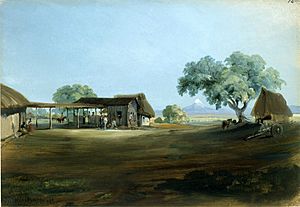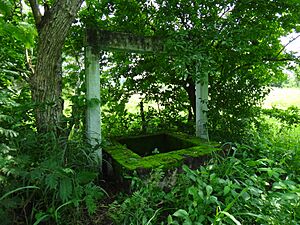Manga de Clavo facts for kids

Manga de Clavo was a very famous property and a favorite home of Antonio López de Santa Anna. He was a powerful leader in Mexico during the early 1800s. Santa Anna lived here and made many important decisions that shaped Mexican politics. It was like his presidential home and government office. Sadly, the United States Army burned and partly destroyed it during the Mexican–American War in 1847–1848.
It's impossible to think of Santa Anna without thinking of Manga de Clavo.
Contents
The Story of Manga de Clavo
Santa Anna bought the hacienda of Manga de Clavo in 1825. This was shortly before he married María Inés de la Paz García, his first wife. She came from a wealthy Spanish family in Alvarado (Veracruz).
How the Hacienda Grew
Over the years, Santa Anna became very influential in the Veracruz region. He was even president of Mexico six times between 1833 and 1855. During this time, he made Manga de Clavo much larger and more beautiful. His estate was in a great spot. It was important for military reasons, politics, and trade. The farms and ranches on Santa Anna's land produced goods for the whole area. This included the cities of Veracruz and Jalapa. The hacienda was right where major roads split off towards Mexico City.
Santa Anna's Leg
Something unusual happened at Manga de Clavo. General Santa Anna's left leg was first buried here. He lost it after being badly hurt by the French. This happened during the Pastry War on December 5, 1838, at the Veracruz dock. His leg stayed at his hacienda for a while. Later, it was moved to a cemetery in Mexico City. This happened on September 27, 1842, the anniversary of Mexico's independence.
A Place for Rest and Decisions
For Santa Anna, Manga de Clavo was a place to relax and have fun. It was also a spot for secret plans and a safe haven when things went wrong. Many times, he would leave the capital and his presidential duties. He would go to Manga de Clavo to find peace and quiet.
We arrived around five at Manga de Clavo. We had traveled through miles of natural garden, all owned by Santa Anna. The house is pretty, light, and well-kept. An aide-de-camp and several officers greeted us. They led us to a large, cool, pleasant room with little furniture. Soon, General Santa Anna himself entered. He was a gentlemanly, good-looking, quietly dressed, rather sad-looking person, with one leg. He has a pale face, beautiful dark eyes that are soft and deep, and an interesting expression. We then looked at the other buildings and offices. There are no formal gardens, but as he said, the entire country, which for twelve square leagues belongs to him, is a garden.
This description comes from Marquise Calderón de la Barca. She was the wife of the Spanish minister to Mexico from 1839 to 1842. She wrote about her visit in her book "Life in Mexico."
The Hacienda's Decline
Manga de Clavo started to lose its importance. Santa Anna was often away. His wife, María Inés, died in 1844. Then, the United States invaded Mexico from 1847 to 1848. These events marked the beginning of the hacienda's downfall.
After the Plan of Ayutla revolution, Santa Anna was forced to leave Mexico for good in 1855. Some of his properties were taken away. Most of the land was sold. Soon, Manga de Clavo was forgotten. It became a ruin.
Later, during the Mexican Revolution (around 1910-1920), large estates were broken up. This likely sped up Manga de Clavo's disappearance. By the 1920s and 1940s, it had become a ruin. It was almost completely lost to history.
Where is Manga de Clavo Today?
In the early 1900s, the town of Vargas grew up around the remains of Manga de Clavo. People used stones from the hacienda to build their homes. This made it hard to find the original mansion. The main house and other buildings were slowly destroyed. Now, only ruins can be found at ground level.
Finding the True Location
Because of this, many people are confused about where Manga de Clavo really was. Some history books, websites, and even TV shows have shared wrong information. Manga de Clavo is often mistaken for other properties Santa Anna owned. These include the hacienda of El Lencero near Jalapa. It is also confused with a residence and barracks near Puente Nacional.
The actual site of Manga de Clavo is in the town of Vargas. It is about 19 miles from the port of Veracruz. Today, only a few foundations, scattered stones, and a well remain. Roberto Williams Garcia, a famous researcher from Veracruz, visited the site in 1967.
I asked for Manga de Clavo and was pointed to a couple of hundred meters from the railway, next to wooden shacks within a low, thin brush. Nearby is "The Well of Santa Anna" without a stone edge and sixty-eight feet deep, with some sort of door halfway down – which I was told – led to a passage, a tunnel...
See also
 In Spanish: Manga de Clavo para niños
In Spanish: Manga de Clavo para niños


